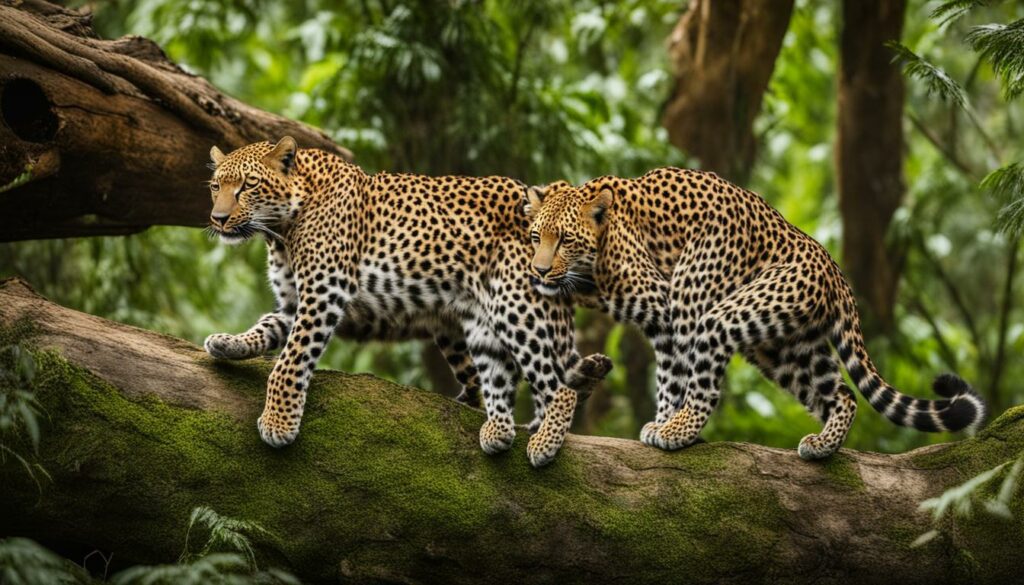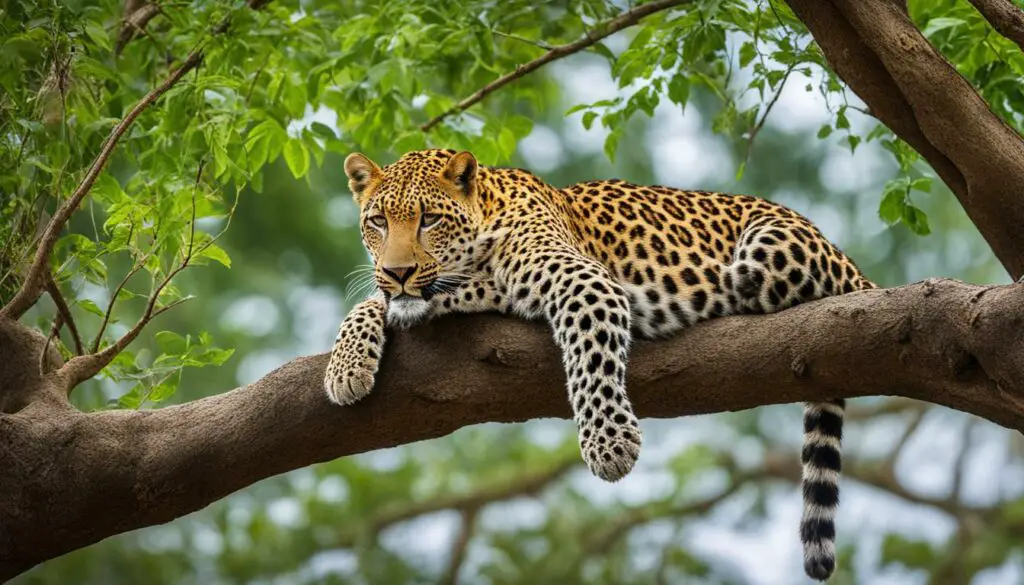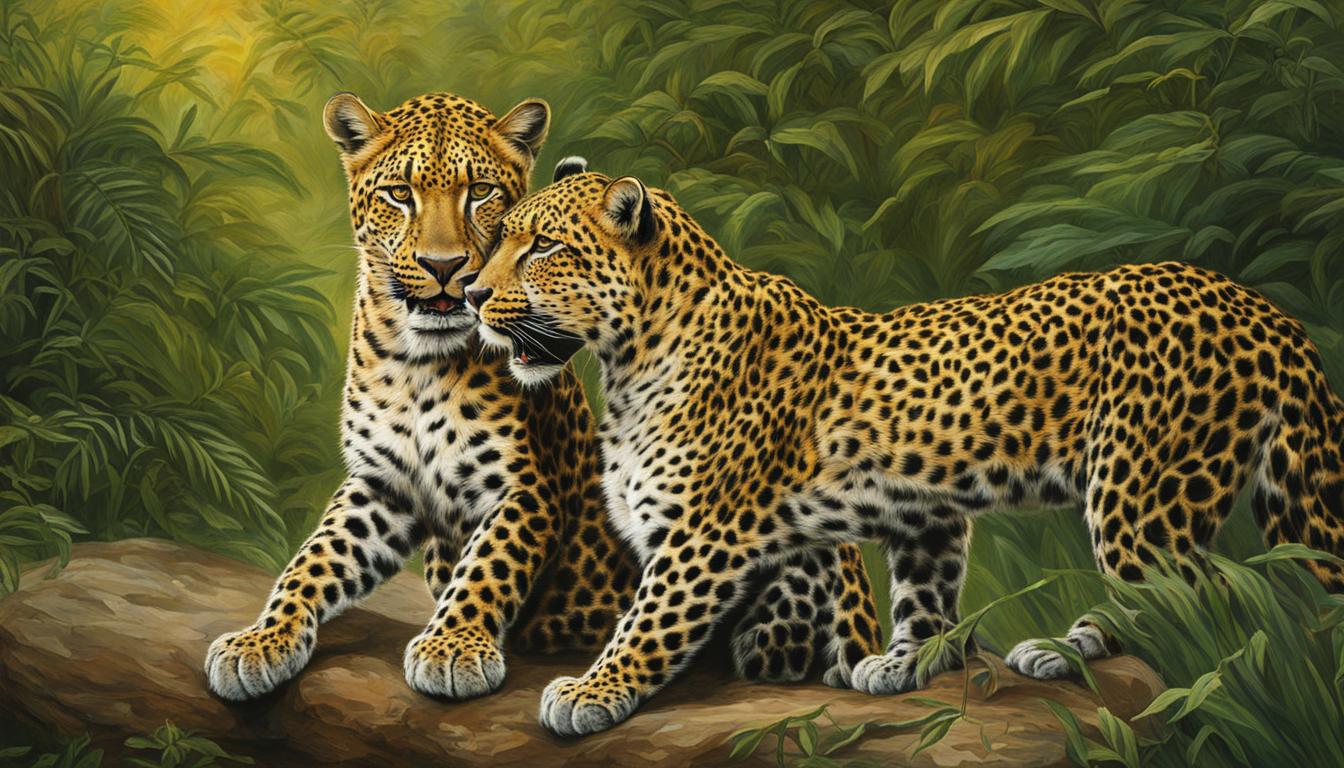Welcome to our comprehensive guide on leopard reproduction. In this article, we will delve into the fascinating world of leopard mating behavior, their reproductive cycle, and the development of their offspring. Understanding these aspects provides valuable insights into the challenges leopards face in ensuring the survival of their species.
Leopard reproduction encompasses various factors, including the breeding season, mating behavior, offspring development, and reproductive strategies. By exploring these topics, we can gain a deeper understanding of the complex nature of leopard reproduction.
Leopards do not have a specific breeding season, but they typically breed once a year. Female leopards typically mate for the first time at around 2 to 2 ½ years old, while males start breeding at 1 ½ years old. Females are in heat for 5-13 days every 2-3 months, and mating is characterized by considerable chasing, occurring on average four times an hour. However, even in areas with abundant food, not all females conceive, with only about 28% of adult female leopards giving birth per year.
Stay tuned for the upcoming sections as we delve deeper into the whelping process, cub development and survival, mating behavior insights from the field, snow leopard reproduction, variation in leopard reproductive strategies, longevity and life expectancy, and a compelling conclusion that highlights the importance of studying leopard reproduction.
The Whelping Process
After a gestation period of 88-112 days, female leopards give birth to a litter of cubs. The litter size typically ranges from 1-2 cubs, with an average of 1.5 cubs. The cubs are born small, weighing 40-60g, and their eyes start opening at around 4-9 days old. By the age of 2 months, they have all their “milk teeth,” and by 2 years old, they have all their permanent teeth. The female leopard cares for the cubs on her own, suckling them for about 4 months.
The cubs begin emerging from the den at around 3-3 ½ months old, gradually exploring their surroundings under the watchful eye of their mother. At this stage, they start eating solid food and learning basic hunting skills. Female leopards invest a significant amount of time and effort in rearing their cubs, ensuring their survival and development.
Female leopards invest a significant amount of time and effort in rearing their cubs, ensuring their survival and development.
The whelping process is a critical phase in the reproduction cycle of leopards. It is during this time that the female leopard provides the necessary care and guidance to her cubs, setting them on a path towards independence. As the cubs grow, they become more self-reliant and gradually learn the skills they need to survive in their environment.
| Aspect | Information |
|---|---|
| Gestation Period | 88-112 days |
| Litter Size | 1-2 cubs (average: 1.5 cubs) |
| Cub Weight at Birth | 40-60g |
| Age When Eyes Open | Around 4-9 days |
| Age When All “Milk Teeth” Present | 2 months |
| Age When All Permanent Teeth Present | 2 years |
| Suckling Period | About 4 months |
| Age When Cubs Start Emerging From Den | Around 3-3 ½ months |
Cub Development and Survival
As leopard cubs grow, they undergo significant development and face various challenges for their survival. From the moment they open their eyes at around 7 days old, the cubs start exploring their surroundings and learning important skills from their mother. At around 2 months old, they begin to eat solid food, transitioning from their mother’s milk. This period marks a crucial milestone in their development, as they start acquiring the necessary nutrients and developing their hunting abilities.
Under the guidance of their mother, leopard cubs gradually learn how to catch their own prey. By 6 months old, they become proficient hunters, relying on their agility and stealth to capture small animals. This early independence is essential for their survival, as they start to rely less on their mother’s hunting skills and more on their own instincts. However, even with their newfound hunting abilities, the survival rate of leopard cubs remains relatively low, with only about 37% of them reaching adulthood.
Leopard cubs face numerous threats that contribute to their low survival rate. Apart from natural predators and competition for resources, leopard cub mortality can be influenced by factors such as disease, infanticide by adult males, and habitat fragmentation. These challenges highlight the importance of understanding leopard cub development and implementing effective conservation strategies to ensure the long-term survival of these magnificent big cats.
The Challenges of Growing Independence
As leopard cubs become more independent, they face a new set of challenges in their journey towards adulthood. At around one year old, they start to distance themselves from their mother and establish their own territories. This period of transition requires them to navigate unfamiliar environments, identify suitable hunting grounds, and avoid conflicts with other leopards.
Surviving in the wild as a young leopard involves adapting to changing circumstances and honing their skills. They must learn to adapt to different prey availability, develop efficient hunting techniques, and refine their ability to conceal themselves from potential threats. The successful development of these crucial skills during this stage significantly contributes to their long-term survival and reproductive success as mature adults.
| Leopard Cub Development Milestones | Age |
|---|---|
| Eyes open | Around 7 days old |
| Start eating solid food | Around 2 months old |
| Begin following mother and learning hunting behavior | Around 3 months old |
| Start catching prey | By 6 months old |
| Reach independence | Around one year old |
Leopard Mating Behavior: Insights from the Field
When it comes to leopard mating behavior, there are fascinating insights that researchers have discovered through field observations. One notable aspect is the duration and frequency of mating. Leopards mate every 15 minutes for up to 5 days, with each mating session lasting only a couple of seconds. This repetitive and intense mating behavior is a crucial part of the reproductive cycle for these magnificent big cats.
Leopards mate every 15 minutes for up to 5 days, with each mating session lasting only a couple of seconds.
During the mating process, the female leopard requires a specific stimulus to start ovulation. This is achieved through the male’s barbed penis, which dig into the female during copulation. This unique aspect of leopard mating behavior sets them apart from other big cat species. Once mating is complete, the males typically leave and do not participate in rearing the cubs. It’s the female leopards who take on the sole responsibility of caring for and raising their offspring.
Another interesting aspect of leopard mating behavior is the variety of locations where mating can occur. It can take place in various settings, including next to the road or in more secluded areas behind shrubs. This shows that leopards are adaptable when it comes to their reproductive rituals and can make use of their surroundings to ensure successful mating. These insights into leopard mating behavior provide us with a deeper understanding of their complex reproductive strategies and highlight the challenges they face in securing the survival of their offspring.
| Leopard Mating Behavior Insights | Description |
|---|---|
| Mating Duration | Mating sessions last only a couple of seconds but occur every 15 minutes for up to 5 days |
| Copulation Frequency | Leopards mate every 15 minutes during the mating period |
| Mating Rituals | Mating can occur in various locations, including next to the road or in secluded areas behind shrubs |
By delving into the intricacies of leopard mating behavior, we gain valuable insights into the reproductive cycle of these magnificent big cats. Understanding their behaviors and rituals helps us appreciate their unique nature and aids in conservation efforts to ensure their continued survival.

Snow Leopard Reproduction: A Unique Cycle
The snow leopard, an elusive and majestic big cat, has a unique reproductive cycle that sets it apart from other leopard species. Let’s delve into the fascinating world of snow leopard reproduction, examining the mating season, pregnancy period, and cub development.
The snow leopard’s mating season occurs between January and mid-March, a relatively short window of opportunity for reproduction. During this time, a male and female snow leopard form a temporary bond and travel together for a few days. This is when the magic happens, as they engage in copulation multiple times to ensure successful fertilization.
After the mating season, the female snow leopard carries her cubs for an average of 93 to 110 days. Their pregnancy concludes in June or July, when the mother gives birth to small and vulnerable cubs. Within a week, the cubs’ eyes open, and they rely on their mother’s care and guidance for survival. As they grow, they begin to consume solid food at two months old and gradually develop the skills needed for hunting.
| Reproductive Aspect | Timeframe |
|---|---|
| Mating Season | January to mid-March |
| Pregnancy Period | 93-110 days |
| Cub Development | Eyes open at around 7 days old, solid food at 2 months old, independence at 18-22 months old |
Did you know? Snow leopards have a relatively low reproductive rate, with females typically giving birth to only two cubs every two years. This slow reproductive rate, combined with other environmental challenges, contributes to the vulnerable status of the snow leopard population in the wild.
The snow leopard’s unique reproductive cycle showcases the adaptability of these magnificent creatures to their harsh mountainous habitats. Understanding their reproduction provides valuable insights into their survival challenges and aids conservation efforts to protect these endangered species.
Variation in Leopard Reproductive Strategies
Leopard reproductive strategies can vary based on factors such as food availability and habitat quality. These variations play a crucial role in shaping the reproductive success of individual leopards. When food resources are abundant, females may produce fewer litters over their lifetime. This may seem counterintuitive, but it is an adaptive response to reduce territorial conflicts and ensure the survival of their offspring. On the other hand, in areas with limited food availability, females may have more frequent litters to compensate for the higher mortality rates of their cubs due to starvation or predation.
Gestation periods in leopards usually last around 88-112 days, but they can differ between individuals. Factors such as the age and health of the female, as well as other environmental conditions, can influence the length of the gestation period. Similarly, litter size can vary, typically ranging from 1-2 cubs. The number of cubs a female produces in each litter is influenced by her physical condition and the availability of resources. It is not uncommon for a female leopard to have only a single cub, especially if she is in poor health or facing food scarcity.
In Table 6.1, we summarize some of the key factors that affect leopard reproductive strategies, including food availability, gestation period, and litter size. This table provides a visual representation of the various factors and how they can vary among individual leopards. It highlights the complexity of leopard reproduction and the need to consider multiple variables when studying their reproductive behavior and strategies.
| Factor | Effect on Reproductive Strategies |
|---|---|
| Food Availability | Influence on litter size and frequency of litters |
| Gestation Period | Can vary between individuals based on factors such as age and health |
| Litter Size | Typically ranges from 1-2 cubs, influenced by resources and maternal condition |
Understanding the variations in leopard reproductive strategies is crucial for their conservation. It allows researchers and conservationists to develop effective management strategies that consider the unique reproductive needs of different leopard populations. By taking into account factors such as food availability, habitat quality, and individual characteristics, we can better protect and preserve these magnificent big cats for future generations.
Longevity and Life Expectancy
Understanding the longevity and life expectancy of leopards is crucial in evaluating their survival and conservation needs. In captivity, leopards have been known to live for as long as 22 years, providing valuable insights into their potential lifespan. However, in the wild, their life expectancy is more likely to be around 10 to 12 years due to the challenges they face in their natural habitats.
These challenges include factors such as competition for resources, predation, and human-related threats. The harsher conditions in the wild, combined with these various threats, contribute to the shorter lifespan compared to captivity. It’s important to note that these figures are based on limited data available from the wild, and further research is needed to gain a more comprehensive understanding of leopard life expectancy in different regions.
When considering the longevity and life expectancy of leopards, it is interesting to compare the lifespan of captive leopards versus those living in the wild. While leopards in captivity can benefit from a controlled environment, regular veterinary care, and a consistent food supply, they still face certain limitations in terms of natural behaviors and overall quality of life. On the other hand, leopards in the wild must navigate a challenging landscape, including adapting to changes in prey availability, avoiding potential threats, and establishing and defending territories.
| Living Environment | Average Lifespan |
|---|---|
| Captivity | 22 years |
| Wild | 10-12 years |
Table: Comparison of average leopard lifespan in different environments.
It is important to continue studying leopard longevity and life expectancy to gather more accurate data and to identify ways to support the conservation of this iconic species. By understanding the factors that influence their lifespan, researchers and conservationists can work towards implementing effective strategies to protect leopard populations and their habitats.

Challenges to Leopard Longevity
Leopards face numerous challenges that can impact their overall longevity and life expectancy. Habitat loss and fragmentation due to human activities, such as deforestation and urban expansion, are major threats that limit their access to suitable territories and prey. Loss of habitat also leads to increased human-wildlife conflict, further endangering the survival of leopards.
Additionally, hunting and poaching pose significant risks to leopard populations. The demand for leopard skins and body parts in illegal wildlife trade drives the targeted killing of these majestic cats. This illegal activity not only decreases leopard numbers but also disrupts their social structure and genetic diversity.
Climate change is another emerging threat that can impact leopard populations. Changes in weather patterns, including increased temperatures and altered rainfall patterns, can disrupt the availability of prey species, leading to food scarcity for leopards. This can directly affect their survival and reproductive success.
Addressing these challenges requires international collaboration and concerted efforts from governments, conservation organizations, and local communities. Implementing effective conservation strategies, such as protected area management, habitat restoration, and anti-poaching initiatives, can contribute to the long-term survival of leopards and ensure a sustainable future for these magnificent big cats.
Conclusion
Understanding leopard reproduction provides insights into their complex mating behavior, reproductive cycle, and the challenges they face in ensuring the survival of their offspring. Factors such as food availability, habitat quality, and interactions with other leopards influence their reproductive strategies.
While leopards exhibit unique behaviors during mating, their overall reproductive success is relatively low, with only a percentage of females giving birth each year. Studying leopard reproduction contributes to our knowledge of these magnificent big cats and helps in their conservation efforts.
By examining the intricacies of leopard reproduction, scientists and conservationists can better understand the factors that impact their population dynamics and implement strategies for their conservation. Protecting their habitats and ensuring a sustainable prey base are crucial for fostering successful reproduction and the long-term survival of these elusive and awe-inspiring creatures.
What are the differences in the mating and reproduction cycles between leopards and cheetahs?
Leopard mating and reproduction cycles generally involve multiple matings with different partners over several days. In contrast, the cheetah mating and reproduction cycle is brief, with the female signaling her readiness to mate to attract males, allowing for a single day of mating.
FAQ
How often do leopards breed?
Leopards usually breed once a year, without a specific breeding season.
At what age do female leopards mate for the first time?
Female leopards mate for the first time at around 2 to 2 ½ years old.
When do male leopards start breeding?
Male leopards start breeding at 1 ½ years old.
How long are female leopards in heat?
Female leopards are in heat for 5-13 days every 2-3 months.
Can female leopards come into heat again if their cubs die?
Yes, if a female leopard’s cubs die, she can come into heat again within two weeks.
How often does mating occur in leopards?
Mating in leopards occurs on average four times an hour.
What is the conception rate for female leopards?
The conception rate for female leopards is relatively low, with only about 28% of adult females giving birth per year.
How long is the leopard gestation period?
Female leopards give birth after a pregnancy of 88-112 days.
What is the typical litter size for leopards?
The litter size for leopards typically ranges from 1-2 cubs, with an average of 1.5 cubs.
Do male leopards help in caring for the cubs?
No, male leopards do not participate in caring for the cubs.
At what age do leopard cubs become independent?
Leopard cubs become independent at around one year old.
How often do leopards mate?
Leopards mate every 15 minutes for up to 5 days, with each mating session lasting only a couple of seconds.
What is the mating behavior of leopards like?
Mating in leopards is characterized by considerable chasing and occurs on average four times an hour.
When is the snow leopard mating season?
The snow leopard mating season is between January and mid-March.
How long is the snow leopard pregnancy period?
Snow leopards are typically pregnant for 93-110 days before giving birth.
Do male snow leopards participate in cub rearing?
No, male snow leopards do not participate in cub rearing.
What is the life expectancy of leopards in the wild?
In the wild, the life expectancy of leopards is around 10 to 12 years.
How long can leopards live in captivity?
Leopards have been known to live for as long as 22 years in captivity.










